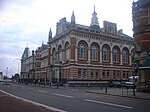Brisbane Road

Brisbane Road, originally known as Osborne Road, is a football stadium in Brisbane Road, Leyton, East London, England. It has been the home ground of Leyton Orient since 1937, before which it was the home of amateur football team Leyton F.C., who moved to the Hare and Hounds ground. Since 2022 it has also been home to Tottenham Hotspur Women. The highest attendance at the ground was 34,345 for the visit of West Ham United in the 1964 FA Cup. It has hosted a number of England U-16 and England women's team matches. It hosted the 2007–08 FA Women's Premier League Cup final. It was also home of the Tottenham Hotspur Reserves. In 2012 Brisbane Road hosted the final of the inaugural NextGen series, a competition for the academy sides of elite clubs.
Excerpt from the Wikipedia article Brisbane Road (License: CC BY-SA 3.0, Authors, Images).Brisbane Road
Brisbane Road, London Leyton (London Borough of Waltham Forest)
Geographical coordinates (GPS) Address Nearby Places Show on map
Geographical coordinates (GPS)
| Latitude | Longitude |
|---|---|
| N 51.56015 ° | E -0.012658333333333 ° |
Address
Brisbane Road
E10 5LP London, Leyton (London Borough of Waltham Forest)
England, United Kingdom
Open on Google Maps







